Elsa Geforce2 MX Specifications
The Geforce2 MX is the budget version of the now famed Geforce2 GTS, the main difference is the slower SDRAM memory rated at 166Mhz, the core is also lower at 175Mhz, because it has a lower clock rate the card doesn't need the fan, so this further cuts costs.Pictures of the Elsa MX
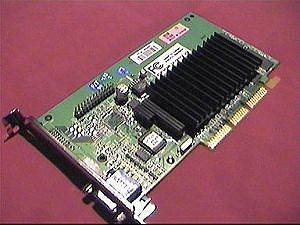

Samsung 6ns 166Mhz
SDRAM
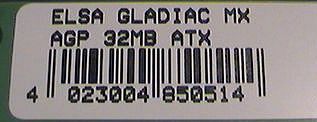
Hmm a bit obvious really The Elsa label
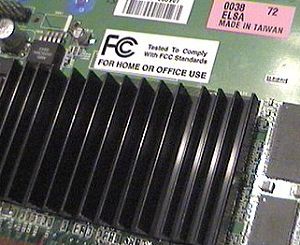
Look no fan
The Geforce2 MX chipset does have a few tricks up it's sleeve, that the GTS doesn't have, Twin View is the first one this allows the MX to support multi monitor configurations and TV output .The various options are show below, standard, and extended desktop and clone configurations. The Elsa card I got unfortunately had only the one standard monitor connection, so I couldn't test the multi monitor configurations.
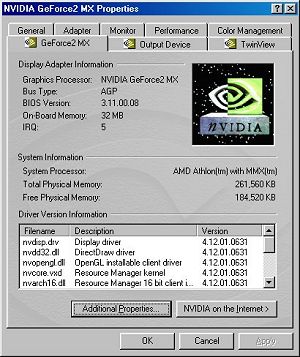
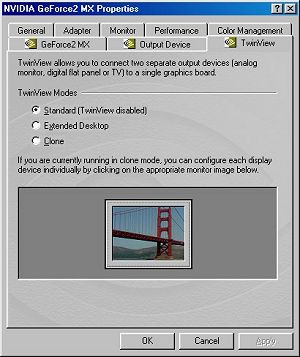
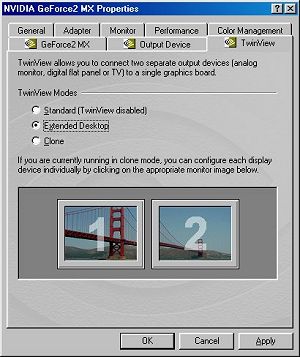
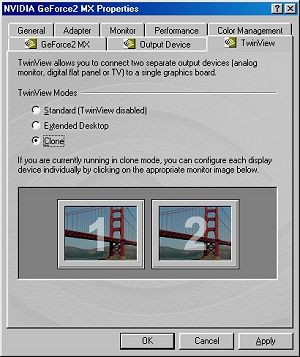
Delving further into the MX control panel you get to the hardware control panel this is activated by installing "coolbits.reg" file

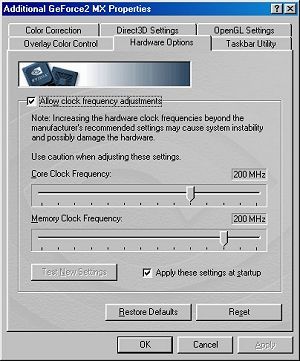
The overclocked settings
I managed to overclock the Elsa MX up to 200 core 200 memory, which improved the score quite a lot as you will see in the benchmarks later. Above 200MHz I got artifacts on the screen..
There is another feature in the MX chipset that isn't present in the GTS, and that is Digital Vibrance control, all this seemed to do is to increase the brightness and colour saturation on my monitor, maybe I'm missing something, but this doesn't seem that useful ?

Here are the tech specs for the Elsa Geforce2 MX
| Equipment | |||||||||||||||||||||||||||||||||||||||||||
| Graphics processor | NVIDIA GeForce2 MX | ||||||||||||||||||||||||||||||||||||||||||
| RAMDAC/pixel cycle | 350 MHz | ||||||||||||||||||||||||||||||||||||||||||
| Memory outfit | 32MB SDRAM | ||||||||||||||||||||||||||||||||||||||||||
| BIOS | VESA BIOS 3.0 support | ||||||||||||||||||||||||||||||||||||||||||
| Bus system | AGP2x/4x, including fast writes and execute mode | ||||||||||||||||||||||||||||||||||||||||||
| Features | |||||||||||||||||||||||||||||||||||||||||||
| Graphics standards | Direct3D, OpenGL, DirectX7, DirectDraw, DirectShow | ||||||||||||||||||||||||||||||||||||||||||
| 2D hardware features | 256-bit 2D acceleration, optimised for 32, 24, 16, 15, and 8 bit colour depths, hardware cursor in TrueColor, multi buffering (double, triple and quadruple for fluid movement and video playback) | ||||||||||||||||||||||||||||||||||||||||||
| 3D hardware features | 256-bit engine with HyperTexel architecture, optimised Direct3D and OpenGL acceleration, complete DirectX7 support, 32-bit Z and stencil buffer, Single pass multi texturing, anti-aliasing, high-quality texture filtering, including anisotropic; advanced per-pixel texturing for perspective correction, fog and depth cueing, texture compression | ||||||||||||||||||||||||||||||||||||||||||
| HDTV and DVD playback | Enhanced motion compensation for full-screen video playback at all DVD and HDTV resolutions, video acceleration for MPEG-1, MPEG-2 and Indeo | ||||||||||||||||||||||||||||||||||||||||||
| Standards | DPMS, DDC2B, plug&play | ||||||||||||||||||||||||||||||||||||||||||
| Connectors | Monitor: D-shell (15 pin) | ||||||||||||||||||||||||||||||||||||||||||
| Dimensions | 165.1 x 63.5 mm (low-profile format, plus mounting bracket) | ||||||||||||||||||||||||||||||||||||||||||
|
|||||||||||||||||||||||||||||||||||||||||||
| The values specified here are maximum values which, under some operating conditions, may not always be achieved. Other graphics modes are easily configured in Windows. | |||||||||||||||||||||||||||||||||||||||||||
Any way enough of the MX introduction, and on with the Elsa Gladiac GTS card









